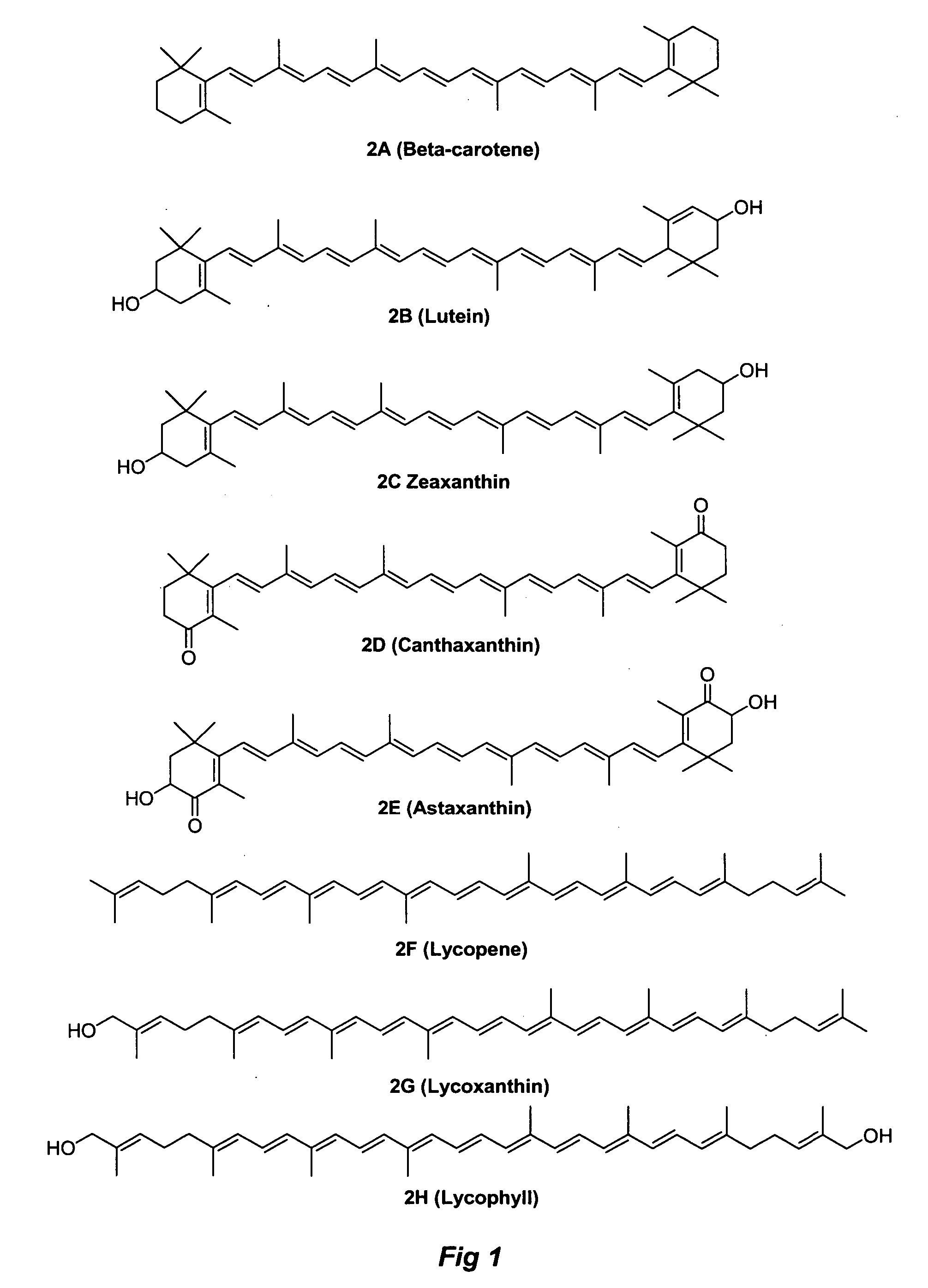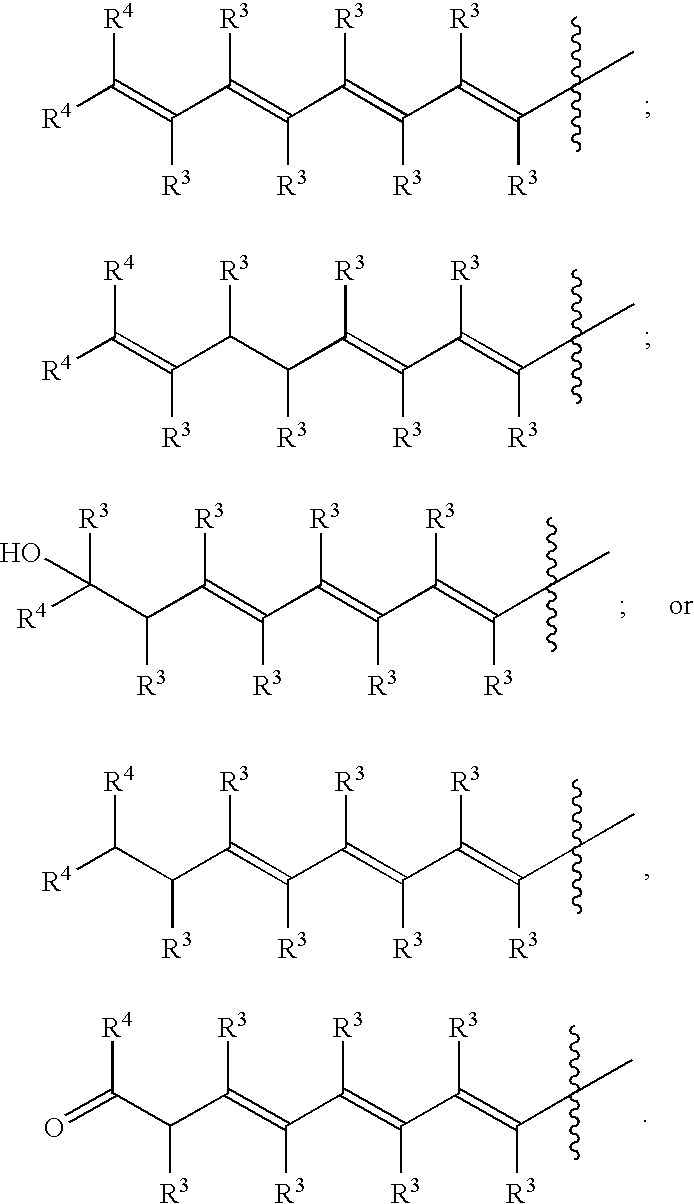Methods for synthesis of carotenoids, including analogs, derivatives, and synthetic and biological intermediates
- Summary
- Abstract
- Description
- Claims
- Application Information
AI Technical Summary
Benefits of technology
Problems solved by technology
Method used
Image
Examples
example 1
Preparation of 2-(Triphenyl-phosphanylidene)-propionic acid ethyl ester
[0197]
QuantityRaw MaterialsFWUsedMolesEthyl 2-bromopropionate181.031.0Kg5.52 molTriphenyl Phosphine262.291.6Kg6.10 molPotassium Carbonate138.21800g5.79 molEtOAc10 LMeOH10 L
[0198] 1.6 Kg (6.10 mol) triphenyl phosphine was dissolved in 10 L ethyl acetate and 1.0 Kg of ethyl 2-bromopropionate was added into the above solution. The reaction mixture was stirred at room temperature for 2 days. White solid was filtered off and the precipitate was washed with ethyl acetate. The resulting compound was dissolved in methanol and treated with saturated aqueous potassium carbonate. After stirring for 2 h, the yellow solid was filtered off and washed with water to give 1.5 Kg (75%) of desired product.
example 2
Preparation of 4-Hydroxy-2-methyl-but-2-enoic acid ethyl ester
[0199]
Raw MaterialsFWQuantity UsedMoles2-(Triphenyl-362.40886 g2.44 molphosphanylidene)-propionic acidethyl esterGlycoaldehyde dimer120.10140 g1.17 molDCM10 L
[0200] 886 g (2.44 mol) of 2-(triphenyl-phosphanylidene)-propionic acid ethyl ester in methylene chloride (4 L) was added dropwise into a refluxing solution of glycoaldehyde dimer (140 g, 1.17 mol) in methylene chloride (6 L). After refluxing for 4 h, the solvent was evaporated. Resulting crude product was fractionated (bp 108-114° C. at 2 mmHg) to give 304 g (90%) pure product as an oil. 1H-NMR (300 Hz CDCl3) δ 6.88 (t, 1H, CH), 4.35 (d, 2H, CH2OH), 4.20 (q, 2H, OCH2), 1.85 (s, 3H, CH3), 1.30 (t, 3H, CH3).
[0201] Note: This process was repeated and 660 g title compound was collected.
example 3
Preparation of 4-Bromo-2-methyl-but-2-enoic acid ethyl ester
[0202]
QuantityRaw MaterialsFWUsedMoles4-Hydroxy-2-methyl-but-2-144.17567g3.93 molenoic acid ethyl esterCarbon tetrabromide331.631.44kg4.34 molTriphenyl phosphine262.291.13kg4.30 molTHF8 L
[0203] To a cooled solution (0° C.) of 4-hydroxy-2-methyl-but-2-enoic acid ethyl ester (567 g, 3.93 mol) in THF (8 L) was added carbon tetrabromide followed by triphenyl phosphine. The reaction mixture was slowly warmed to room temperature and stirred overnight. White solid (identified as compound 6) was isolated by filtering. The filtration was condensed and added ether, the resulting white precipitated (identified as triphenyl phosphate and triphenyl phosphine) was filtered off and discarded. Ether was evaporated and the resulting crude product was used without further purification in the next step.
[0204] Note: This process was repeated until 660 g of 4-hydroxy-2-methyl-but-2-enoic acid ethyl ester was consumed.
PUM
| Property | Measurement | Unit |
|---|---|---|
| Volume | aaaaa | aaaaa |
| Volume | aaaaa | aaaaa |
| Volume | aaaaa | aaaaa |
Abstract
Description
Claims
Application Information
 Login to View More
Login to View More - R&D
- Intellectual Property
- Life Sciences
- Materials
- Tech Scout
- Unparalleled Data Quality
- Higher Quality Content
- 60% Fewer Hallucinations
Browse by: Latest US Patents, China's latest patents, Technical Efficacy Thesaurus, Application Domain, Technology Topic, Popular Technical Reports.
© 2025 PatSnap. All rights reserved.Legal|Privacy policy|Modern Slavery Act Transparency Statement|Sitemap|About US| Contact US: help@patsnap.com



